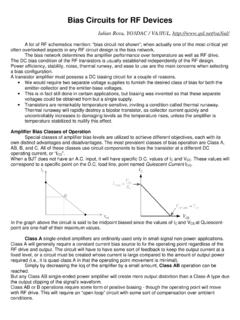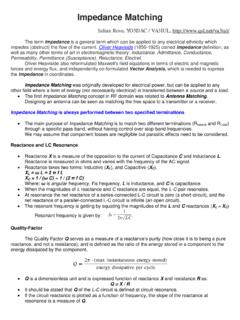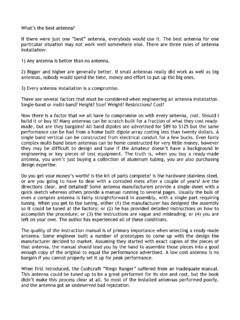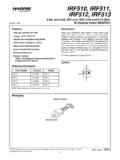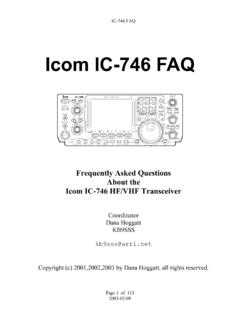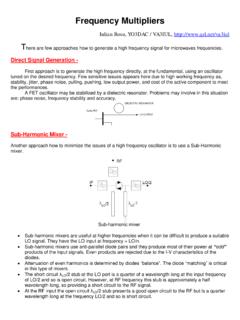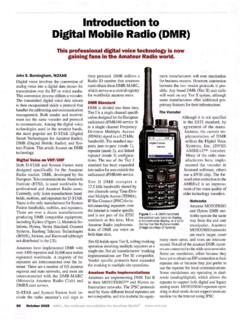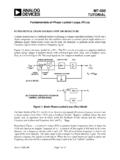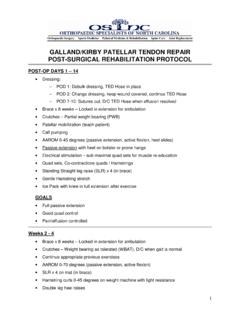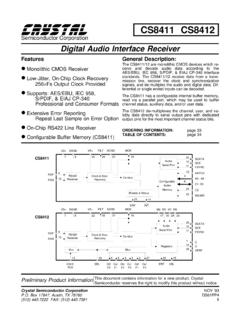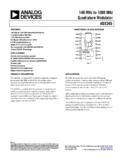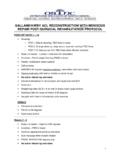Transcription of Processing Gain for Direct Sequence Spread TM …
1 1 TMAN9633 Processing gain for Direct Sequence SpreadSpectrum Communication Systems and PRISM IntroductionThis application note addresses theconcept of Processing gain (PG) ofDirect Sequence Spread Spectrum(DSSS) systems. The PRISM chipsetis used to implement DSSS radio designs. The processinggain provides the unique properties to the DSSS waveformprimarily in terms of interference tolerance. The PG of aDSSS system is centered around the utilization of randomcodes which are used in conjunction with the data. Theserandom codes are referred as Pseudo Noise (PN) HSP3824 provides this coding capability for the a DSSS system random binary data with a bit rate ofrbbits per sec (bps) is multiplied (Exclusive Ored) by apseudorandom binary waveform, which is at much higherrate and it provides the frequency spreading operation.
2 Thispseudorandom (PN) binary source outputs symbols calledchips at a constant chip rate rCchips per sec (cps). This is arandom, noise like signal and hence the name PN chip rate is always higher than the bit rate, and the ratioof the chip rate to the bit rate is defined as the processinggain (PG) [3]. The PG is a true signal to jammer(interference) ratio at the receiver after the despreadingoperation (removal of PN).The rate of the PN code is the one that defines thebandwidth of the transmitted Spread receiver of a DSSS system must remove the spreadingas the first step in the demodulation the despreading operation the receiver mustgenerate a phase locked exact replica of the pseudorandomspreading waveform to match the transmitted signal.
3 This isachieved by the code acquisition, and code tracking loopsembedded in the HSP3824. The receiver PN Sequence mustbe exactly in phase with the transmitted PN Sequence , andthis is achieved by correlation TransceiverA DSSS transmitter is shown in Figure 1. The data isdenoted by d(t), the spreading signal is denoted by c(t), andthe Spread waveform q(t) is fed to the BPSK modulatoroperating at a carrier frequency fC, and the transmittedsignal is denoted by x(t).A text book conceptual block diagram of a DSSS receiver isdepicted in Figure 2. Note that PRISM is architected toperform the despreading function at baseband (HSP3824)rather than at RF as shown on Figure 2.
4 This example isused for illustration of the concept and not to reflect theactual PRISM received signal for this text book example is thecombination of the transmitted Spread spectrum signal and anarrow band jammer xJ(t). The locally generateddespreading Sequence is denoted by c (t), and should beequal to c(t). The despread signal is then band pass filteredbefore data demodulation and d (t) should be equal to d(t).PG BenefitsThe primary benefit of Processing gain is its contributiontowards jamming resistance to the DSSS signal. The PNcode spreads the transmitted signal in bandwidth and itmakes it less susceptible to narrowband interference withinthe Spread BW. The receiver of a DSSS system can beviewed as unspreading the intended signal and at the sametime spreading the interfering waveform.
5 This operation isbest illustrated on Figure 3 depicts the power spectral density (psd) functionsof the signals at the receiver input, the despread signal, thebandpass filter power transfer function, and the band passfilter output. Figure 3 graphically describes the effect of theprocessing gain on a jammer. The jammer is narrow, andhas a highly peaked psd, while the psd of the DSSS is wideand low. The despreading operation spreads the jammerpower psd and lowers its peak, and the BPF output showsthe effect on the signal to jammer 16. DSSS TRANSMITTERd(t)q(t)c(t)x(t)COS( O t)CODEGENERATORFIGURE 17. DSSS RECEIVERd (t)y(t)c (t)x(t) + xj (t)COS( O t)PNGENERATORBPFH(f)x (t)LPFA pplication NoteAugust 1996 Authors: John Fakatselis1-888-INTERSIL or 321-724-7143|Intersil and Design is a trademark of Intersil Corporation.
6 |Copyright Intersil Corporation. 2000 PRISM is a registered trademark of Intersil Corporation. PRISM and design is a trademark of Intersil for example, BPSK modulation is used and an Eb/No oflets say 14dB is required to achieve a certain BERperformance, when this waveform is Spread with aprocessing gain of 10dB then the receiver can still achieveits required performance with the signal having a 4dB poweradvantage over the interference. This is derived from the14dB required minus the 10dB of higher the Processing gain of the DSSS waveform themore the resistance to interference of the DSSS classical definition of Processing gain is the 10 Lognumber [rC/rB] in dB.
7 By this definition a system that has adata rate of 1 MBPS and a chip rate (rate of PN code) of1 MCPS will have a PG of Using the PRISM chipset each data bit is x-ored with an 11 bit Sequence for thisparticular example. The Processing gain can be then viewedas the 10 Log[11]dB where 11 is the length of the PN code. Ifa code with a length of 16 bits is to be used then theprocessing gain is equivalent to 10 Log[16] dB or this end these PN signals must posses certainmathematical properties to be useful as part of a DSSS system. Primarily the PN codes that are useful must havevery good autocorrelation and crosscorrelation properties aswell as maintaining some randomness DSSS receiver is utilizing a reference PN sequencewhich is a replica to the transmitted Sequence and when itdetects correlation between the reference and the incomingsequences it declares initial acquisition and it establishesinitial symbol timing.
8 Any partial correlations can result tofalse acquisitions and degradation to the receiverperformance. This is why the PN code must have goodcorrelation properties. Some of the PN code classes withsuch properties are described paper highlights the Barker codes, Willard codes andm-sequences with 7 and 15 chips per period which areimplementable using the CodesPN codes with the mathematical properties required forimplementation of a DSSS radio are:Maximum Length SequencesMaximum length sequences (m-sequences), are PNsequences that repeat every 2n-1, where n is an integer,they are implemented by shift registers and Exclusive Orgates, they are governed by primitive polynomials, andpossess good randomness properties including a two-valued autocorrelation function [4].
9 For example the 7 chip PN Sequence is governed by theprimitive polynomial generatorc7(x) = 1 + x2 + x3and the output chips are given by:0 0 1 0 1 1 10 0 1 0 1 1 10 0 1 0 1 1 10 0 1 0 1 1 4 depicts the d(t), c(t) with the above m- Sequence ,and with q(t) the x-or of d(t) and (ct).FIGURE 18A. PSD OF Spread SPECTRUM SIGNAL AND NAR-ROWBAND JAMMERFIGURE 18B. PSD OF DESPREAD SIGNAL AND JAMMERFIGURE 18C. POWER TRANSFER FUNCTION OF BPFFIGURE 18D. PSD OF BPF OUTPUTFIGURE 18. Processing gain EFFECT ON NARROW BAND JAMMINGSX(f) + SJ(f)Tc/2fCfJAMMER PSDSPREAD SPECTRUMSIGNAL PSDfCTB/2SX(f)JTC/2 DESPREADDESPREADJAMMERSIGNALfCf1|H(f)|2f CfTB/2SY(f)JTC/2 SIGNALJAMMERA pplication Note 96333 Figure 5 depicts the 7 chip Sequence and its autocorrelationfunction.
10 Note that the autocorrelation also repeats every 7chips, or once per bit of the actual data if each of the databits is Spread by the entire another example, the 15 chip PN Sequence is governedby the primitive polynomial generatorc15(x) = 1 + x3 + x4and the output chips are given by:0 0 0 1 0 0 1 1 0 1 0 1 1 1 10 0 0 1 0 0 1 1 0 1 0 1 1 1 10 0 0 1 0 0 1 1 0 1 0 1 1 1 CodesBarker Codes are short unique codes that exhibit very goodcorrelation properties. These short codes with N bits, withN=3 to 13, are very well suited for DSSS applications andcan all be generated by the HSP3824. A list of Barker Codesis tabulated in Table CodesWillard Codes, found by computer simulation andoptimization, and under certain conditions, offer betterperformance than Barker Codes.
